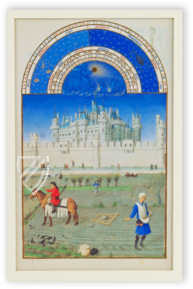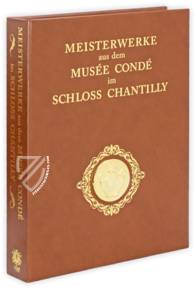Splendor of Knighthood
(under 1,000€)
The knight is the figure most closely associated with the Middle Ages. Specifically, it is a title granted by a monarch or prince of the church, e.g. a bishop, in recognition of their service as a warrior. This fearsome class of fighting men attempted to regulate their own behavior by cultivating a code chivalry in the High Middle Ages that dictated their conduct both on the battlefield and in daily life, especially with respect to women, according to Christian principles. The ideal knight was brave and strong, but also selfless, merciful, and attempted to channel his violence into good causes like protecting the weak or even Christendom itself. This enduring ideal of the chivalric knight is evidenced by the continuing existence of knightly orders today, even if they are now stripped of their military purposes and are mostly charitable organizations.
Splendor of Knighthood
Knights were typically members of the lower nobility hoping to rise through military service and who characteristically fought from horseback. During peacetime, knights displayed their martial skills in medieval tournaments, a mixture of spectacle and controlled violence, in which knights were usually injured and sometimes killed. These ranged from grand events to duels and brawls that were sparked by an insult to one party’s honor. As heraldry developed, knights became identifiable by their individual coats of arms. Once the chivalric ideal emerged in the High Middle Ages, knights became symbols for a code of conduct that was defined by Christian morality. The Crusades helped to create the ideal of the Christian knight. A Crusader knight or one joining a monastic military order like the Templars would paint over their coat of arms, replacing it with a simple cross as a sign that they were abandoning their personal ambitions in order to serve Christ. Various figures, both historical and mythical, influenced the image of a knight, and include Julius Caesar, Alexander the Great, and St. George. The mythical King Arthur and his Knights of the Roundtable were inspirations for stories of the very real Charlemagne (742–814) and his Paladins, who were mythicized versions of Charlemagne’s best knights.
This collection of ten pages from splendidly illuminated manuscripts gives an overview of imagery associated with the ideal of the chivalric knight:
1. The Patron Saint: Michael
Apocalypse, Metropolitan Museum of Art, New York
France, ca. 1320
The Ideal of the Knight: St. George
Breviary of the Duke of Bedford, Bibliothèque Nationale, Paris
Paris, ca. 1425–1435The Feudal Lord: King and Emperor Otto III
Gospels of Otto III, Bayerische Staatsbibliothek, Munich
Reichenau, ca. 1000The Knight and his Armor: King David
Psalter, Österreichische Nationalbibliothek, Vienna
France, ca. 1280The Ancient Model: Alexander the Great
Alexander Romance, Bodleian Library, Oxford
Flanders, ca. 1338–1344Tradition and Present: Caesar Crosses the Rubicon
Histoire ancienne jusqu’à César et faits des Romains, Musée du Louvre, Paris
France, ca. 1460The Courtly Epic: Tristan and Isolde
Roman de la Poire, Bibliothèque Nationale, Paris
France, ca. 1275The Battle for the Holy Land: Crusaders before Jerusalem
Burchardus Teutonicus: Descriptio Terrae Sanctae, Biblioteca del Seminario, Padua
Upper Italy, late–13th centuryThe Knightly Poet: Hartmann von Au
Great Heidelberg Book of Songs (Codex Manesse), Universitätsbibliothek, Heidelberg
Zürich, early–14th centuryAutumn of Chivalry: Mary of Burgundy and Maximilian I
Hours of Mary of Burgundy, Österreichische Nationalbibliothek, Vienna
Ghent, ca. 1467–1480
Codicology
- Alternative Titles
- Kassette Glanz des Rittertums
- Origin
- France
- Date
- 9th–15th century
- Genre
- Illustrations
- 10 miniatures
- Content
- Ten leaves from important manuscripts
Breviary of the Duke of Bedford
The Ideal of the Knight: St. George
As a member of the Praetorian Guard for Emperor Diocletian, George of Lydda was a part of the Roman army’s elite. However, the Cappadocian Greek soldier refused to recount his Christian faith and was thus put to death. Venerated as a military saint since the Crusades, he is famously depicted slaying a dragon demanding human sacrifices and in doing so saves the next sacrifice – a princess of course, who is shown holding the dragon with a leash as St. George stabs its neck with a spear.

Gospels of Otto III
Donor Portrait
His Majesty, the Emperor Otto III, is shown here looking out directly at the beholder holding the imperial orb in one hand and a scepter crowned with an eagle in the other. Otto’s gaze is confident to the point of being hypnotic and has clearly stylized himself as an heir to the Caesars of Ancient Rome. He is flanked by his counsellors: military men on one side and clerics on the other.
Otto III was focused on Italian politics and this portrait clearly indicates his self-image as an heir to the Romans. He is pictured seated beneath a classical architecture with column capitals featuring human faces. Only the finest materials have been employed here: a rich diversity of opaque colors and the generous use of gold leaf.

#1 Kassette Glanz des Rittertums
Language: German
(under 1,000€)
- Treatises / Secular Books
- Apocalypses / Beatus
- Astronomy / Astrology
- Bestiaries
- Bibles / Gospels
- Chronicles / History / Law
- Geography / Maps
- Saints' Lives
- Islam / Oriental
- Judaism / Hebrew
- Single Leaf Collections
- Leonardo da Vinci
- Literature / Poetry
- Liturgical Manuscripts
- Medicine / Botany / Alchemy
- Music
- Mythology / Prophecies
- Psalters
- Other Religious Books
- Games / Hunting
- Private Devotion Books
- Other Genres
- Afghanistan
- Armenia
- Austria
- Belgium
- Colombia
- Croatia
- Czech Republic
- Denmark
- Egypt
- Ethiopia
- France
- Germany
- Hungary
- India
- Iran
- Iraq
- Israel
- Italy
- Japan
- Luxembourg
- Mexico
- Morocco
- Netherlands
- Peru
- Poland
- Portugal
- Russia
- Serbia
- Spain
- Sri Lanka
- Sweden
- Switzerland
- Syria
- Turkey
- Ukraine
- United Kingdom
- United States
- Uzbekistan
- Aboca Museum
- Ajuntament de Valencia
- Akademie Verlag
- Akademische Druck- u. Verlagsanstalt (ADEVA)
- Aldo Ausilio Editore - Bottega d’Erasmo
- Alecto Historical Editions
- Alkuin Verlag
- Almqvist & Wiksell
- Amilcare Pizzi
- Andreas & Andreas Verlagsbuchhandlung
- Archa 90
- Archiv Verlag
- Archivi Edizioni
- Arnold Verlag
- ARS
- Ars Magna
- ArtCodex
- AyN Ediciones
- Azimuth Editions
- Badenia Verlag
- Bärenreiter-Verlag
- Belser Verlag
- Belser Verlag / WK Wertkontor
- Benziger Verlag
- Bernardinum Wydawnictwo
- BiblioGemma
- Biblioteca Apostolica Vaticana (Vaticanstadt, Vaticanstadt)
- Bibliotheca Palatina Faksimile Verlag
- Bibliotheca Rara
- Boydell & Brewer
- Bramante Edizioni
- Brepols Publishers
- British Library
- C. Weckesser
- Caixa Catalunya
- Canesi
- CAPSA, Ars Scriptoria
- Caratzas Brothers, Publishers
- Carus Verlag
- Circulo Cientifico
- Club Bibliófilo Versol
- Club du Livre
- CM Editores
- Collegium Graphicum
- Collezione Apocrifa Da Vinci
- Comissão Nacional para as Comemorações dos Descobrimentos Portugueses
- Coron Verlag
- Corvina
- CTHS
- D. S. Brewer
- De Agostini/UTET
- De Schutter
- Deuschle & Stemmle
- Deutscher Verlag für Kunstwissenschaft
- DIAMM
- Droz
- E. Schreiber Graphische Kunstanstalten
- Ediciones Boreal
- Ediciones Grial
- Ediclube
- Edições Inapa
- Edilan
- Editalia
- Edition Georg Popp
- Edition Leipzig
- Edition Libri Illustri
- Editiones Reales Sitios S. L.
- Éditions de l'Oiseau Lyre
- Editions Medicina Rara
- Editorial Casariego
- Editorial Mintzoa
- Editrice Antenore
- Editrice Velar
- Edizioni Edison
- Egeria, S.L.
- Eikon Editores
- Electa
- Enciclopèdia Catalana
- Eos-Verlag
- Ephesus Publishing
- Eugrammia Press
- Extraordinary Editions
- Fackelverlag
- Facsimila Art & Edition
- Facsimile Editions Ltd.
- Facsimilia Art & Edition Ebert KG
- Faksimile Verlag
- Feuermann Verlag
- Folger Shakespeare Library
- Franco Cosimo Panini Editore
- Friedrich Wittig Verlag
- Fundación Hullera Vasco-Leonesa
- G. Braziller
- Gabriele Mazzotta Editore
- Gebr. Mann Verlag
- Gesellschaft für graphische Industrie
- Getty Research Institute
- Giovanni Domenico de Rossi
- Giunti Editore
- Graffiti
- Grafica European Center of Fine Arts
- Guido Pressler
- Guillermo Blazquez
- H. N. Abrams
- Harrassowitz
- Helikon
- Hendrickson Publishers
- Henning Oppermann
- Herder Verlag
- Hes & De Graaf Publishers
- Hoepli
- Hortus Deliciarum
- Houghton Library
- Hugo Schmidt Verlag
- Idion Verlag
- Il Bulino, edizioni d'arte
- ILte
- Imago
- Insel Verlag
- Instituto de Estudios Altoaragoneses
- Instituto Nacional de Antropología e Historia
- Istituto dell'Enciclopedia Italiana - Treccani
- Istituto Ellenico di Studi Bizantini e Postbizantini
- Istituto Geografico De Agostini
- Istituto Poligrafico e Zecca dello Stato
- Italarte Art Establishments
- J. Thorbecke
- Jan Thorbecke Verlag
- Johnson Reprint Corporation
- Jugoslavija
- Karl W. Hiersemann
- Kasper Straube
- Kaydeda Ediciones
- Konrad Kölbl Verlag
- Kurt Wolff Verlag
- La Liberia dello Stato
- La Linea Editrice
- La Meta Editore
- Lambert Schneider
- Landeskreditbank Baden-Württemberg
- Leo S. Olschki
- Les Incunables
- Library of Congress
- Libreria Musicale Italiana
- Lichtdruck
- Lito Immagine Editore
- Lumen Artis
- Lund Humphries
- M. Moleiro Editor
- Maison des Sciences de l'homme et de la société de Poitiers
- Manuscriptum
- Maruzen-Yushodo Co. Ltd.
- MASA
- McGraw-Hill
- Militos
- Millennium Liber
- Müller & Schindler
- National Library of Wales
- Neri Pozza
- Nova Charta
- Oceanum Verlag
- Odeon
- Orbis Mediaevalis
- Orbis Pictus
- Österreichische Staatsdruckerei
- Oxford University Press
- Pageant Books
- Parzellers Buchverlag
- Patrimonio Ediciones
- Pattloch Verlag
- PIAF
- Pieper Verlag
- Plon-Nourrit et cie
- Prestel Verlag
- Princeton University Press
- Prisma Verlag
- Priuli & Verlucca, editori
- Pro Sport Verlag
- Propyläen Verlag
- Pytheas Books
- Quaternio Verlag Luzern
- Reales Sitios
- Recht-Verlag
- Reichert Verlag
- Reichsdruckerei
- Riehn & Reusch
- Roberto Vattori Editore
- Rosenkilde and Bagger
- Roxburghe Club
- Salerno Editrice
- Sarajevo Svjetlost
- Schöck ArtPrint Kft.
- Scolar Press
- Scrinium
- Scripta Maneant
- Scriptorium
- Siloé, arte y bibliofilia
- SISMEL - Edizioni del Galluzzo
- Sociedad Mexicana de Antropología
- Sorli Ediciones
- Stainer and Bell
- Styria Verlag
- Sumptibus Pragopress
- Szegedi Tudomànyegyetem
- Taberna Libraria
- Tarshish Books
- Taschen
- Tempus Libri
- Testimonio Compañía Editorial
- Thames and Hudson
- The Clear Vue Publishing Partnership Limited
- The Facsimile Codex
- The Folio Society
- The Marquess of Normanby
- The Richard III and Yorkist History Trust
- Tip.Le.Co
- TouchArt
- TREC Publishing House
- TRI Publishing Co.
- Trident Editore
- Typis Regiae Officinae Polygraphicae
- Universidad de Granada
- University of California Press
- University of Chicago Press
- Urs Graf
- Vallecchi
- Van Wijnen
- VCH, Acta Humaniora
- VDI Verlag
- Verlag für Regionalgeschichte
- Verlag Styria
- Vicent Garcia Editores
- W. Turnowsky
- Wiener Mechitharisten-Congregation (Wien, Österreich)
- Wissenschaftliche Buchgesellschaft
- Xuntanza Editorial
- Zollikofer AG













